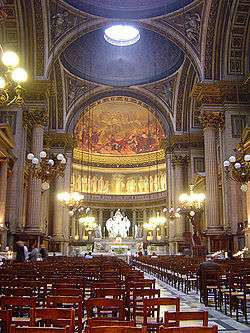Jacques-Marie Huvé

Jacques-Marie Huvé (28 April 1783 in Versailles – 1852) was a French architect who practiced in Paris, working in a neoclassical manner that he refined working in the atelier of Percier and Fontaine, Napoleon's chief architects.
Huvé was the son of an architect, Jean-Jacques Huvé, with whom he received his earliest instruction. He was named supervisor of the works at the Église de la Madeleine in 1808, and at the decease of its architect, Pierre-Alexandre Vignon, in 1828, Huvé was called upon to bring the work to completion. With tenacity he pressed the government to release the funding that permitted the church to be completed in 1842.
He was appointed architect of the Royal Mails, was admitted a member of the Académie des Beaux-Arts (the Institut de France's architecture, music, and fine arts section) and served as president of the Société des Beaux-Arts.
Huvé trained in his studio the renowned architect Eugène Viollet-le-Duc. At the École des Beaux-Arts he was the professor notably of Gustave Guérin and of Charles Laisné.
His only son, Félix Huvé, was mayor of Sablé.
Principal works
- Église de la Madeleine, Paris, which he finished 1828-42
- Château de Saint-Ouen, built on behalf of Louis XVIII for Zoé Talon, comtesse du Cayla, 1821-1822.
- Château de Compiègne
|